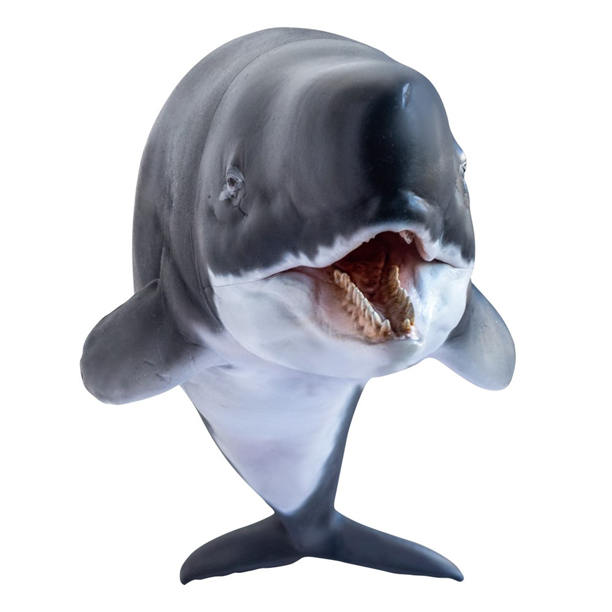Tiny Whale Fossil Indicates Evolution of Baleen Whales from Toothed Cetaceans
The Baleen Whales, huge creatures such as the Blue Whale (Balaenoptera musculus) and the Grey Whale (Eschrichtius robustus) feed by gulping in huge amounts of water, and straining out small sea creatures such as krill through their plates of bristle-like baleen that hang from the upper jaws. However, these leviathans may have evolved from huge marine predators that specialised in eating much larger prey.
Museum Victoria palaeontologist Dr Erich Fitzgerald has made ground-breaking discoveries on the evolution of the world’s largest whales, the Baleen Whales, based on 25 million-year-old fossil jaws found near Torquay in Victoria (Australia).
The Evolution of Baleen Whales
Published today in the Royal Society’s journal Biology Letters, this important discovery challenges earlier scientific notions by suggesting that Baleen Whales (e.g. Blue Whales), which feed on small organisms, first evolved their huge mouths for capturing large individual prey animals.
The new fossil evidence comes in the form of the lower jaw bones of Janjucetus, (Janjucetus hunderi) a 3-metre-long early relative of today’s toothless baleen whales.
Dr Fitzgerald commented:
“Janjucetus had tightly connected lower jaws and lacked the elastic lower jaw joint that makes it possible for the mouths of modern Baleen Whales to greatly expand and swallow vast volumes of plankton-rich seawater. What this amounts to is vivid evidence that Janjucetus and the earliest baleen whales could not filter feed.”
Dr Fitzgerald’s research challenges the belief that the earliest Baleen Whales had the same jaw structure as their modern day relatives. The newly uncovered fossils suggest that early Baleen Whales had bizarrely shaped skulls structured for sucking prey into their mouths.
Whale Fossils
Dr Erich Fitzgerald cradles the fossil jaws of the tiny extinct whale (Janjucetus hunderi). With a total body length of only three metres, this Oligocene marine mammal would have been dwarfed by its present day relative, the Blue Whale, a skeleton of which looms in the background.
Dr Fitzgerald added:
“Their skull, mouth and lips may have acted like vacuum cleaners, hoovering up larger animals, like fishes or octopuses.”
Although this fossil discovery shows Janjucetus had a rigid lower jaw joint, their upper jaws were expansive – a key feature of all Baleen Whales.
According to Dr Fitzgerald:
“The characteristic large mouth of today’s Baleen Whales is first seen in the upper jaws of non-filter feeding early species, suggesting that the wide upper jaws originally evolved as a specialisation for suction feeding.”
Although the steps by which Baleen Whales evolved from suction feeders into filter feeders remains unclear, this research demonstrates the first evolutionary step towards what are now the biggest mouths in the history of life on Earth.
Janjucetus hunderi
Images released show Janjucetus hunderi attacking a school of fish in the seas off the coast of south-east of Australia, twenty-five million years ago.
Describing just how big the mouth of a Blue Whale (Balaenoptera musculus) is, Dr Fitzgerald stated:
“When fully expanded, a blue whale’s mouth could park a Kombi van.”
Janjucetus hunderi lived about 25 million years ago in coastal seas off south-east Australia. The fossil jaws of Janjucetus were found near the Victorian township of Torquay in the 1970s by a dedicated amateur palaeontologist. Little had been established about the whale remains until Dr Erich Fitzgerald started his long-term research on the fossils in 2009.
Dr Fitzgerald is a palaeontologist specialising in the evolution of marine mammals. He held a Post-doctoral Fellowship at the Smithsonian Institution and is currently the Harold Mitchell Fellow at Museum Victoria. Erich also holds an honorary appointment at the Smithsonian Institution in Washington, DC. This research is a result of two years of study at Museum Victoria and the Smithsonian Institution.
Museum Victoria houses the largest collection of fossil marine mammals in Australia and hosts the country’s only whale evolution research program. The paper published in the scientific journal “Biology Letters” is entitled “Archaeocete-like jaws in a Baleen Whale.”
Everything Dinosaur is grateful to Melbourne Museum and Museum Victoria for their help in the compilation of this article.
Some Toothed Whales were Giant Apex Predators (Livyatan)
The picture (above), shows the PNSO Requena the Livyatan model. To view the prehistoric animals in the PNSO model range: PNSO Prehistoric Figures and Replicas.







Leave A Comment